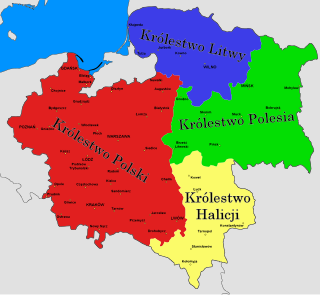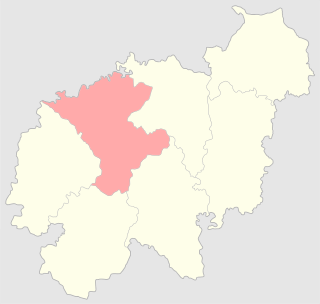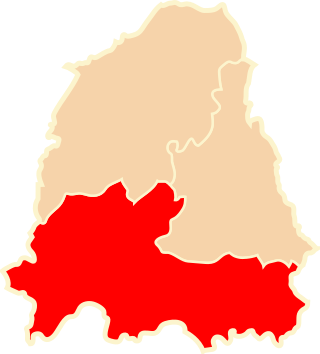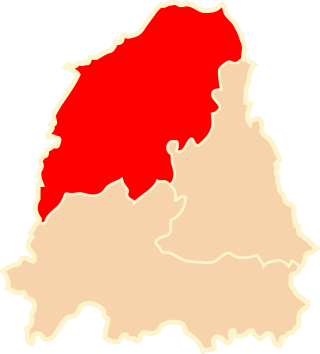
Vilnius County is the largest of the 10 counties of Lithuania, located in the east of the country around the city Vilnius and is also known as Capital Region by the statistics department and Eurostat. On 1 July 2010, the county administration was abolished, and since that date, Vilnius County remains as the territorial and statistical unit.

The Republic of Central Lithuania, commonly known as the Central Lithuania, and the Middle Lithuania, was an unrecognized short-lived puppet republic of Poland, that existed from 1920 to 1922. It was founded on 12 October 1920, after Żeligowski's Mutiny, when soldiers of the Polish Army, mainly the 1st Lithuanian–Belarusian Infantry Division under Lucjan Żeligowski, fully supported by the Polish air force, cavalry and artillery, attacked Lithuania. It was incorporated into Poland on 18 April 1922.

Vilnius University is a public research university, oldest in the Baltic states and in Northern Europe outside the United Kingdom, Denmark and Sweden. Today it is Lithuania's leading academic institution, ranked among the top 400 (QS) or top 800 (ARWU) universities worldwide. As of 2022 QS ranks VU as 8th in CEE ; an ARWU equivalent would be 11th.

The Wilno Voivodeship was one of 16 Voivodeships in the Second Polish Republic, with the capital in Wilno. The jurisdiction was created in 1926 and populated predominantly by Poles, with notable minorities of Belarusians, Jews and Lithuanians. Before 1926, the voivodeship's area was known as the Wilno Land; it had the same boundaries and was also within the contemporary borders of Poland at the time.
The city of Vilnius, now the capital of Lithuania, and its surrounding region has been under various states. The Vilnius Region has been part of the Grand Duchy of Lithuania from the Lithuanian state's founding in the late Middle Ages to 1569, then since 1569 to 1795 Vilnius region was part of Polish-Lithuanian Commonwealth. From then, the region was occupied by the Russian Empire until 1915, when the German Empire invaded it. After 1918 and throughout the Lithuanian Wars of Independence, Vilnius was disputed between the Republic of Lithuania and the Second Polish Republic. After the city was seized by the Republic of Central Lithuania with Żeligowski's Mutiny, the city was part of Poland throughout the Interwar period. Regardless, Lithuania claimed Vilnius as its capital. During World War II, the city changed hands many times, and the German occupation resulting in the destruction of Jews in Lithuania. From 1945 to 1990, Vilnius was the Lithuanian Soviet Socialist Republic's capital. From the dissolution of the Soviet Union, Vilnius has been part of Lithuania.

Vilnius Region is the territory in present-day Lithuania and Belarus that was originally inhabited by ethnic Baltic tribes and was a part of Lithuania proper, but came under East Slavic and Polish cultural influences over time.

Jan Brunon Bułhak (1876–1950) was an early 20th century photographer in Poland and present-day Belarus and Lithuania. A published theoretician and philosopher of photography, he was an exponent of pictorialism. He is best known for his landscapes and photographs of various places, especially the city of Vilnius. He was the founder of the Wilno Photoclub and Polish Photoclub, the predecessors of the modern Union of Polish Art Photographers (ZPAF), of which he was an honorary office-holder. He is also known as an ethnographer and folklorist.

The Vilna Governorate was a governorate of the Northwestern Krai of the Russian Empire. In 1897, the governorate covered the area of 41,907.9 square kilometres (16,180.7 sq mi) and a population of 1,591,207 inhabitants. The governorate was defined by the Minsk Governorate to the south, the Grodno Governorate to the southwest, the Suwałki Governorate to the west, the Kovno and Courland Governorates to the north, and the Vitebsk Governorate to the east. The administrative centre was located in the city of Vilna. The city also served as the administrative centre of the Vilna Governorate-General, which existed until 1912. The area roughly corresponded to the Vilnius Region, which was later occupied by Germany, Bolsheviks, and Poland.

Żeligowski's Mutiny was a Polish false flag operation led by General Lucjan Żeligowski in October 1920, which resulted in the creation of the Republic of Central Lithuania. Polish Chief of State Józef Piłsudski surreptitiously ordered Żeligowski to carry out the operation, and revealed the truth only several years afterwards. The area was formally annexed by Poland in 1922 and recognized by the Conference of Ambassadors as Polish territory in 1923. The decision was not recognized by Lithuania, which continued to claim Vilnius and the Vilnius Region, and by the Soviet Union.

Wilno Land was a district of Poland, with capital in Vilnius, that existed from 13 April 1922 until 20 January 1926. The territory was formed in 1922 from territories of the Republic of Central Lithuania incorporated into Poland, and a 3 counties from Nowogródek Voivodeship. In 1926, the territory was transformed into the Wilno Voivodeship, becoming the last voivodeship of the Second Polish Republic to be formed. It had an area of 27,849 km2 (10,753 sq mi) and in 1925, it was inhabited by 973,404 people.

United States of Poland was an unrealized political concept of reborn Poland, created by Ignacy Jan Paderewski (1860–1941). It was first presented in Paderewski Memorial, given to US President Woodrow Wilson on 11 January 1917.

The Vilna uezd was a county (uezd) of the Vilna Governorate of the Russian Empire, with the administrative centre in Vilna. The uezd was bordered by the Sventsyany uezd to the east, the Oshmyany and Lida uezds to the south, the Troki uezd to the west, and the Vilkomir uezd of the Kovno Governorate to the north. The district covered the area of modern Vilnius County of Lithuania.

Civil Administration of the Eastern Lands was a civil authority of the territories controlled by Second Polish Republic but not incorporated into the state itself, that was formed during the Polish–Soviet War in 1919 and existed until 1920. It was formed on 19 February 1919 from the territories taken by Poland during the war, that were previously occupied by the Russian SFSR. In the summer of 1920, forces of Russian SFSR had conquered the area. After part of the area was reconquered by Poland, the administration was formally disestablished on 9 September 1920, and replaced by the Provisional Administration of Front-line and Phase Territories.

Wilno County was a county with capital in Vilanus located in the Republic of Central Lithuania, and later de jure in Wilno Land, Second Polish Republic. Between 1920 and 1922 it was a county in Republic of Central Lithuania, established in place of former Vilensky Uyezd, Vilna Governorate. In 1922, following the incorporation of Central Lithuania into Poland, the county become a part of then established Wilno Land. In 1921, the county had informally united with Troki County, and between 1923 and 1924 they had been formally transformed into Wilno-Troki County. In 1921, from the county was separated city of Vilanus, that was reformed into a separate county.

Treaty of Kaunas was a treaty signed on 29 November 1920 in Kaunas, Lithuania, that the next day started the armistice between Lithuania and Central Lithuania ending the Central Lithuanian Offensive on Kaunas. The treaty was drafted between 27 and 29 November 1920, during the peace negotiations between Lithuania and Poland led by the League of Nations.

Civil Administration of the Lands of Volhynia and Podolian Front, also known as Commissariat of the Lands of Volhynia and Podolian Front was a civil authority of the territories controlled by Second Polish Republic but not incorporated into the state itself, that was formed during the Polish–Soviet War in 1920. It was formed on 17 January 1920 from the Civil Administration of the Eastern Lands and included Volhynian District and the surrounding area. In the summer of 1920, forces of Russian SFSR had conquered the area. After part of the area was reconquered by Poland, the administration was formally disestablished on 9 September 1920, and replaced by the Provisional Administration of Front-line and Phase Territories.
Chief of District was a public official in Second Polish Republic with the power to govern the districts. He was a representative of the Council of Ministers, responsible for the implementation of the laws as well as superior to local administration offices.

Brześć District was a district of the Civil Administration of the Eastern Lands from June 1919 to September 1920, and Provisional Administration of Front-line and Phase Territories from September 1920 to December 1920, all of which were under the control of the Second Polish Republic. Its seat was located in Brest-Litovsk. In December 1919, it had an area of 57,758 km², and was inhabited by 1,121,978 people.

Mińsk District was a district of the Civil Administration of the Eastern Lands from September 1919 to September 1920, and Provisional Administration of Front-line and Phase Territories from September 1920 to December 1920, all of which were under the control of the Second Polish Republic. Its seat was located in Minsk. In December 1919, it had an area of 35,947 km², and was inhabited by 1 091 138 people.

Wilno District was a district of the Civil Administration of the Eastern Lands from June 1919 to September 1920, and Provisional Administration of Front-line and Phase Territories from September 1920 to December 1920, all of which were under the control of the Second Polish Republic. Its seat was located in Vilnius. In December 1919, it had an area of 48,466 km², and was inhabited by 1,633,504 people.
















